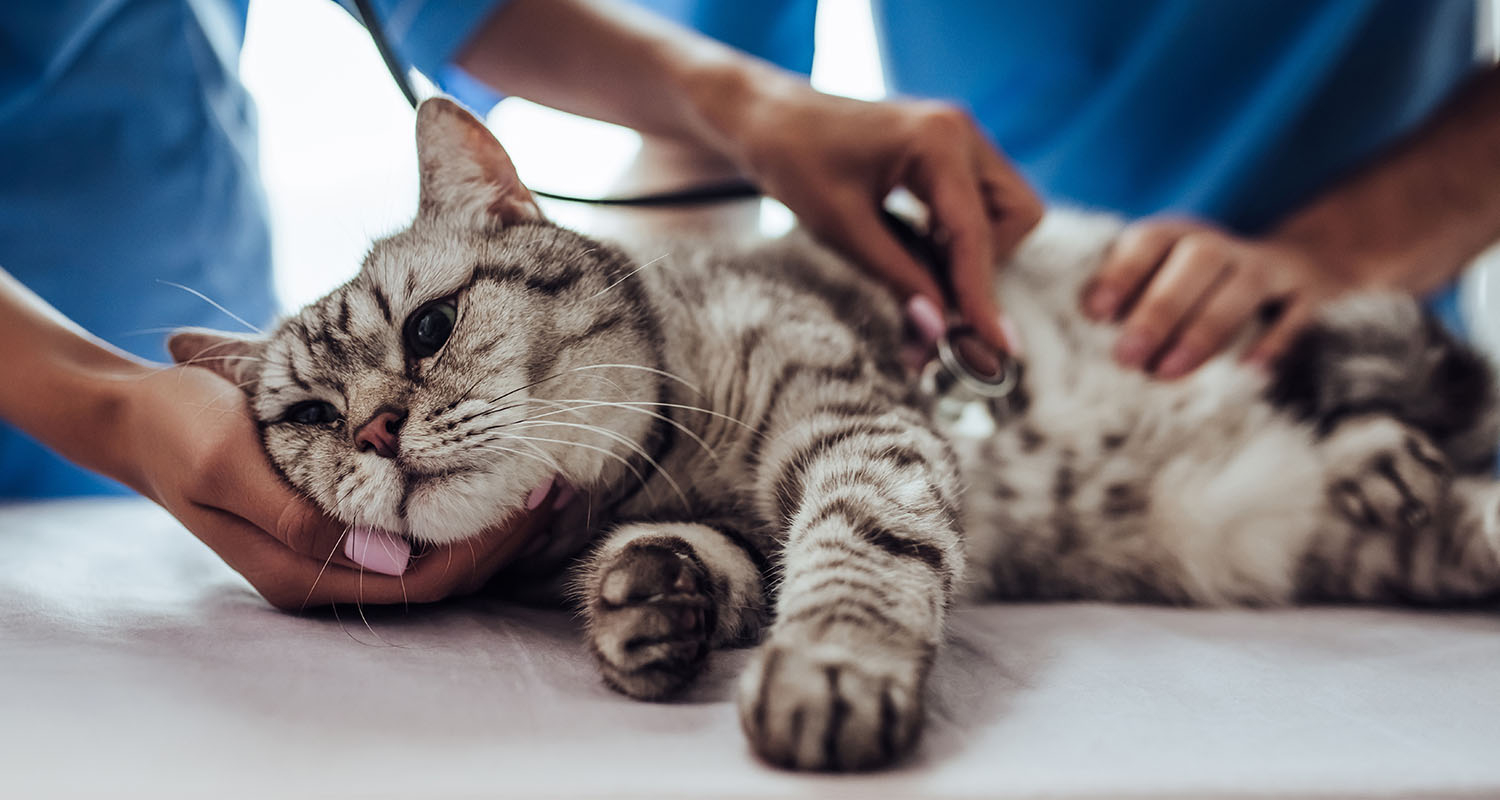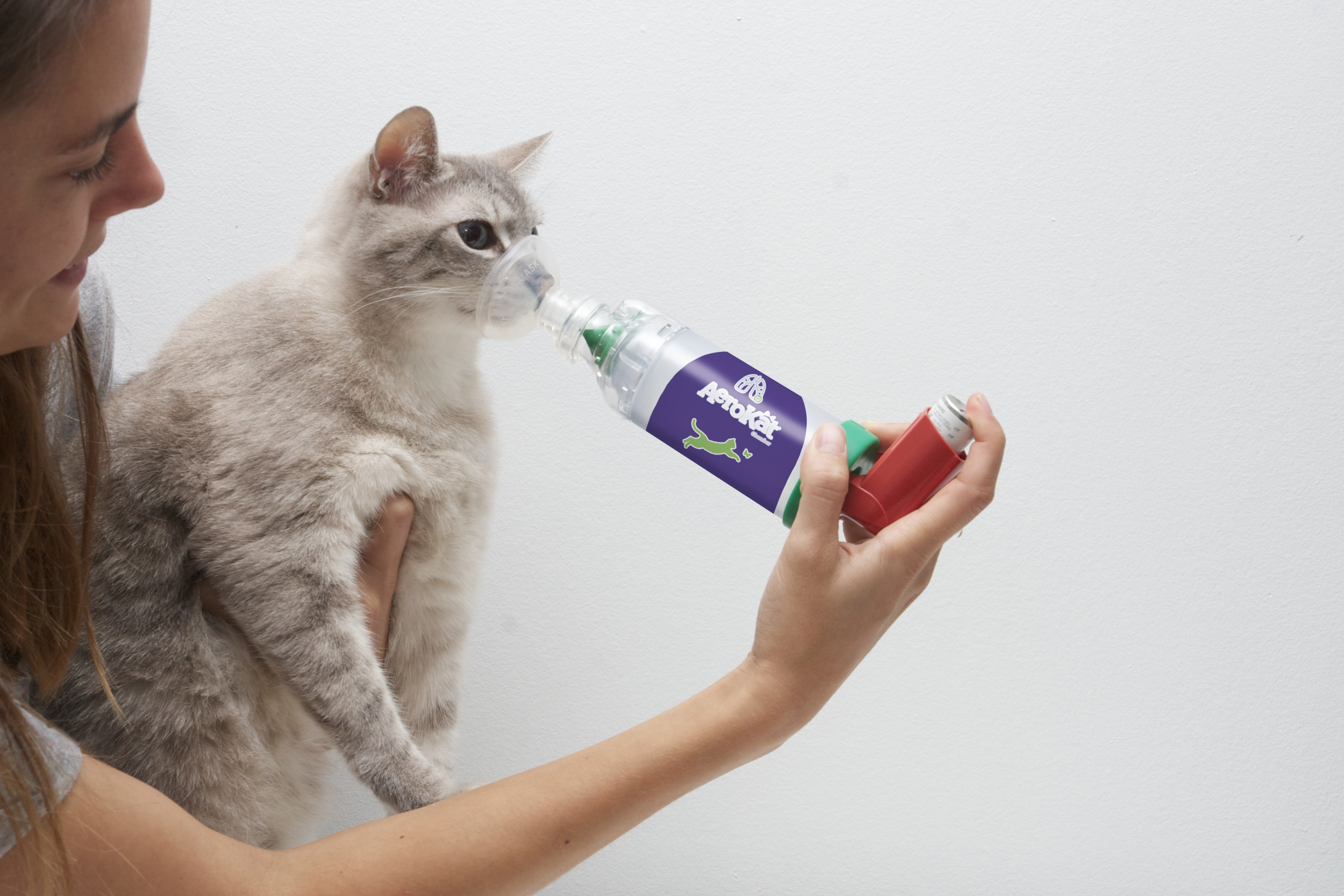
Bronchodilator Medications For Cats: What They Are, Types Available, And Why Inhaled Medication Is Preferred
This article is part of our Cat Asthma series.
Download the Full Guide to Cat Asthma
Bronchodilators are important medications used in the treatment of feline lower airway diseases. These medications work by dilating the small muscles in the airways, allowing more air to enter the lungs.
Instead of being used for daily disease management, bronchodilators are usually given when a cat is in distress (such as during an asthma attack). As such, they are commonly referred to as rescue medications.
These medications are available in systemic (oral/injected) or inhaled forms.
What Are Bronchodilators Used For In Cats?
Bronchodilators are used to relieve symptoms of lower airway disease in cats. These conditions include:
- Feline asthma
- Chronic bronchitis
Bronchodilators make it easier for your cat to breathe, providing quick relief when symptoms flare up. Inhaled bronchodilator medications can take full effect within 5-10 minutes of administration.1
Bronchodilators should not be the only medication used to manage feline asthma since they do not address the underlying inflammation. Bronchodilators are effective when used to treat asthma flare-ups and attacks while inhaled corticosteroids are the primary medication of choice for daily disease management.

The Difference Between Inhaled & Systemic Bronchodilators
The benefit of using inhaled bronchodilators (versus systemic bronchodilators in oral or injectable form) is the medication is delivered directly to the area where it is needed: the lungs. This means the drug works quickly because it doesn’t need to be processed by the body first. It also greatly reduces the risk of side effects.
Another important benefit of using inhaled bronchodilators is ease of administration. If a cat is in respiratory distress, it is important to be able to get the medication into them quickly and easily. It can be very difficult to give a pill to a cat in normal conditions but it is even harder when they are struggling to breathe. Injections are another alternative, but taking your cat to the vet for injection can be risky when your cat is in need of immediate relief.
One of the main differences between inhaled bronchodilators and systemic dilators is the risk of side effects. Because systemic bronchodilators need to be processed by the body, they can affect other areas in addition to the lungs.
Some of the side effects of systemic bronchodilators include:
- Tachycardia
- Central nervous system (CNS) stimulation
- Tremors
- Hypokalemia
- Increased gastric acid secretion
- Gastrointestinal upset2
How Are Inhaled Bronchodilators Given To Cats?
Giving an inhaler to your cat isn’t as difficult as it may seem. Inhaled medications are prescribed in the form of a metered dose inhaler (MDI). It’s important to understand how to give a feline inhaler to your cat so they can receive the medication they need.
As cats cannot be instructed to take a breath to inhale the medication, they require special equipment to make sure they get the full dose of medication. The inhaler is administered to cats with a feline inhaler spacer device (such as the AeroKat* Chamber).
Spacer devices include a mask and a chamber so your cat can inhale the medication in several breaths. The AeroKat Chamber is designed to hold the medication in the chamber longer so more medication is available for your cat to breathe in. This is especially important because during a flare-up, your cat’s breathing will be faster and shallower and they will need more breaths through the chamber to empty it. As a result, it is critical to use a chamber that can hold the medication long enough for your cat to inhale the dose.

Types Of Bronchodilators Available
The bronchodilator drugs used to treat asthma or chronic bronchitis in cats are beta2-receptor agonists and methylxanthine derivatives.3 Of the two, beta2-receptor agonists are the most commonly prescribed bronchodilators for cats.
There are several types of these bronchodilator medications available, including:
1. Albuterol/Salbutamol
Also referred to as brand names Proair, Proventil, or Ventolin, albuterol (or salbutamol) is an inhaled beta2-receptor agonist. It is used to treat both feline asthma and bronchitis and is administered using a metered dose inhaler (MDI).
2. Terbutaline
Also referred to as brand names Brethine, Bricanyl, and Brethaire, terbutaline is a systemic beta2-receptor agonist. It is primarily used to treat feline asthma and is administered as a tablet or injection.
3. Levalbuterol
Also referred to as brand name Xopenex, Levalbuterol is a less common inhaled beta2-receptor agonist. It is used to treat both feline asthma and bronchitis. Levalbuterol is available in a nebulizer solution or a metered dose inhaler, but is not commonly prescribed for cats.
4. Theophylline
Also referred to as brand names Theo 24, Theochron, Elixophyllin, Aminophylline, and Uniphyl, theophylline is a systemic methylxanthine derivative that may be used for ongoing respiratory condition treatment in dogs than cats.4 Theophylline is administered as a tablet.
Inhaled Bronchodilator Dosage For Cats
Inhaled bronchodilators are normally prescribed with a dose of 1-2 puffs per treatment5, depending on severity of symptoms and size of the cat.
Most metered dose inhalers hold 200 puffs of medication. Your vet will indicate when the medication is to be used and how many puffs to give your cat for each treatment.
Where To Get Feline Bronchodilator Inhalers
Your cat will first need to be prescribed a bronchodilator for their condition by a veterinarian. Albuterol (or Salbutamol) is the most commonly prescribed inhaled bronchodilator. Albuterol inhalers for cats are available online or at a pharmacy. Depending on the country, inhaled bronchodilators may cost between $5 - $30 per inhaler and typically last several months when used as indicated. In addition to the metered dose inhaler, you will also need to purchase a spacer device to properly administer the medication to your cat.
Terbutaline is also commonly prescribed, but isn’t as effective as inhaled medication and poses serious potential side effects. Terbutaline for cats is available online or at a pharmacy.

Use Inhaled Bronchodilators To Keep Your Cat Safe
Inhaled bronchodilators are important medications needed to help your cat during a flare-up of asthma or bronchitis, which can be a potentially life-threatening situation.
Ask your vet about using inhaled bronchodilators and the AeroKat* Chamber to help relieve your cat’s symptoms (and ultimately keep your cat safe).
For additional information about treating cat asthma or bronchitis, check out the following resources:
How To Use A Cat Inhaler To Treat Feline Asthma
Treating Asthma In Cats: Medications, Efficacy, & Side Effects
Take the Feline Asthma Assessment to see if your cat could have asthma.
1 International Cat Care, ”Asthma In Cats” (https://icatcare.org/advice/asthma-in-cats/)
2 Claire Sharp, BSc, BVMS (Hons), MS, Diplomate ACVECC, Today’s Veterinary Practice, “Treatment of Feline Lower Airway Disease” (https://todaysveterinarypractice.com/treatment-of-feline-lower-airway-d…)
3 Claire Sharp, BSc, BVMS (Hons), MS, Diplomate ACVECC, Today’s Veterinary Practice, “Treatment of Feline Lower Airway Disease” (https://todaysveterinarypractice.com/treatment-of-feline-lower-airway-d…)
4 Claire Sharp, BSc, BVMS (Hons), MS, Diplomate ACVECC, Today’s Veterinary Practice, “Treatment of Feline Lower Airway Disease” (https://todaysveterinarypractice.com/treatment-of-feline-lower-airway-d…)
5 Trudell Medical International, “AeroKat* Feline Aerosol Chamber” (https://www.trudellmed.com/sites/default/files/inline-files/aerokat-dos…)
